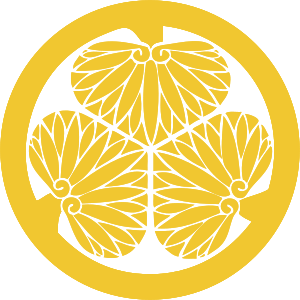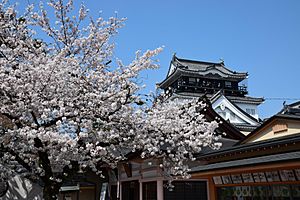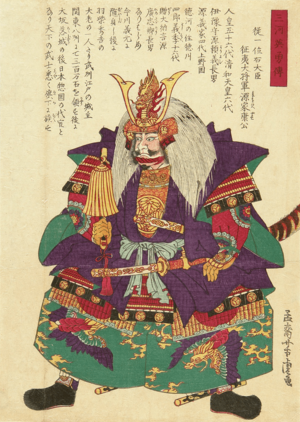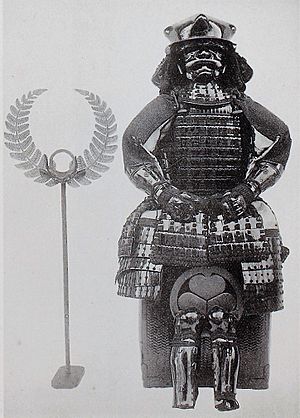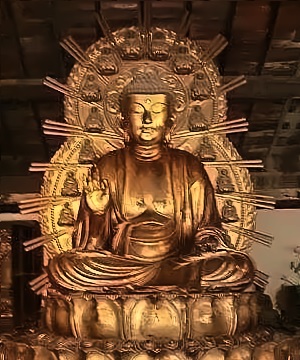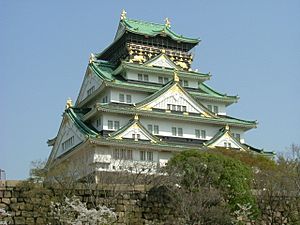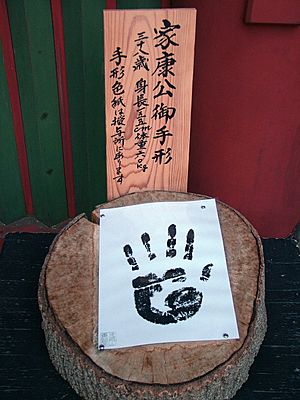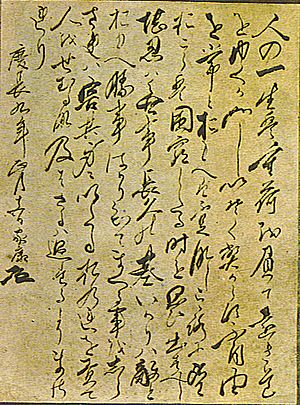Tokugawa Ieyasu facts for kids
Quick facts for kids
Tokugawa Ieyasu
|
|||||
|---|---|---|---|---|---|
|
徳川 家康
|
|||||
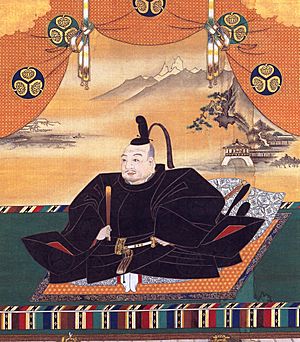 |
|||||
| Shōgun | |||||
| In office 1603–1605 |
|||||
| Monarch | Go-Yōzei | ||||
| Preceded by | Ashikaga Yoshiaki | ||||
| Succeeded by | Tokugawa Hidetada | ||||
| Head of Matsudaira clan | |||||
| In office 1549–1616 |
|||||
| Preceded by | Matsudaira Hirotada | ||||
| Succeeded by | Tokugawa Hidetada | ||||
| Head of Tokugawa clan | |||||
| In office 1567–1616 |
|||||
| Succeeded by | Tokugawa Hidetada | ||||
| Chancellor (Daijō-daijin) of Japan | |||||
| In office May 2, 1616 – June 1, 1616 |
|||||
| Personal details | |||||
| Born |
Matsudaira Takechiyo
(松平 竹千代) January 31, 1543 Okazaki Castle, Mikawa (now Okazaki, Japan) |
||||
| Died | June 1, 1616 (aged 73) Sunpu, Tokugawa shogunate (now Shizuoka, Japan) |
||||
| Spouses |
|
||||
| Children |
Among others... |
||||
| Parents |
|
||||
| Other names |
|
||||
| Signature |  |
||||
| Military service | |||||
| Allegiance |
|
||||
| Unit | Tokugawa clan | ||||
| Commands | Edo Castle | ||||
| Battles/wars | Siege of Terabe Siege of Marune Siege of Kaminogō Battle of Batogahara Tōtōmi Campaign Battle of Anegawa Battle of Mikatagahara Battle of Nagashino Siege of Takatenjin Battle of Tenmokuzan Battle of Komaki and Nagakute Siege of Odawara Kunohe Rebellion Sekigahara Campaign Osaka Campaign see below |
||||
| Japanese name | |||||
| Hiragana | とくがわ いえやす | ||||
| Katakana | トクガワ イエヤス | ||||
| Kyūjitai | 德川 家康 | ||||
| Shinjitai | 徳川 家康 | ||||
|
|||||
Tokugawa Ieyasu (born Matsudaira Takechiyo on January 31, 1543 – died June 1, 1616) was a very important leader in Japanese history. He founded the Tokugawa shogunate, a powerful government that ruled Japan for over 250 years, from 1603 until 1868.
Ieyasu is known as one of the three "Great Unifiers" of Japan. The other two were Oda Nobunaga and Toyotomi Hideyoshi. These leaders helped end a long period of wars and bring peace to the country.
Ieyasu started as the son of a minor daimyo (a powerful Japanese lord). He even lived as a hostage for a time. But he grew stronger, first serving under Oda Nobunaga. After Nobunaga's death, Ieyasu became a rival to Toyotomi Hideyoshi before joining forces with him.
Hideyoshi moved Ieyasu to the Kantō region in eastern Japan. There, Ieyasu built his castle in a small fishing village called Edo (which is now Tokyo). He became the most powerful daimyo under Hideyoshi. After Hideyoshi died, Ieyasu took control of Japan in 1600, winning the important Battle of Sekigahara.
In 1603, he became the first shōgun (military ruler) of Japan. He stepped down in 1605 but still held power until his death in 1616. Ieyasu created a system to keep the other lords and warriors in check, ensuring a long period of peace and stability for Japan.
Contents
- Ieyasu's Early Life and Challenges (1543–1556)
- Serving Under Imagawa Yoshimoto (1556–1560)
- Ieyasu's Rise to Power (1560–1570)
- Ieyasu and Nobunaga (1570–1582)
- Tokugawa Expansion (1582–1584)
- Ieyasu and Hideyoshi (1584–1598)
- Rise to Power (1591–1599)
- Unifying Japan (1599–1603)
- Becoming Shōgun (1603–1605)
- The Retired Shōgun (1605–1616)
- Death
- Ieyasu's Character
- See also
Ieyasu's Early Life and Challenges (1543–1556)
Ieyasu was born at Okazaki Castle in a place called Mikawa Province. His birth name was Matsudaira Takechiyo. His father, Matsudaira Hirotada, was a local lord who controlled a part of a main road. His family's land was caught between two stronger neighbors: the Imagawa clan to the east and the Oda clan to the west. The Oda clan was led by Oda Nobuhide, who was the father of Oda Nobunaga.
When Takechiyo was born, his family was divided. His father's uncle joined the Oda clan. This made the Oda clan confident enough to attack Okazaki. Because of these troubles, Ieyasu's father divorced his mother and sent her away. Ieyasu later had many half-brothers and sisters.
Living as a Hostage
As the Oda clan kept attacking, Ieyasu's father asked the powerful Imagawa clan for help. The Imagawa leader, Imagawa Yoshimoto, agreed, but only if Takechiyo was sent to him as a hostage.
When Takechiyo was five years old, the Oda clan kidnapped him. Nobuhide threatened to kill Takechiyo if his father didn't break ties with the Imagawa. But Ieyasu's father refused, saying that sacrificing his son would show how serious he was about his alliance. Nobuhide didn't kill Takechiyo. Instead, he held him hostage for three years. It's said that Oda Nobunaga met Takechiyo during this time.
In 1549, when Takechiyo was six, his father was murdered by his own men, who had been bribed by the Oda clan. Around the same time, Oda Nobuhide died from a sickness.
In 1551, the Imagawa army rescued Takechiyo. So, at nine years old, Takechiyo was taken to Sunpu as a hostage again. He was treated well there, as the Imagawa saw him as a possible future ally. He stayed there until he was 14.
Serving Under Imagawa Yoshimoto (1556–1560)
In 1556, Takechiyo became an adult in a special ceremony. He changed his name to Matsudaira Jirōsaburō Motonobu. He was allowed to visit his home, Okazaki, to honor his father and meet his loyal followers.
A year later, at 15, he married his first wife, Lady Tsukiyama, who was related to Imagawa Yoshimoto. He changed his name again to Matsudaira Kurandonosuke Motoyasu. Their son, Matsudaira Nobuyasu, was born a year later. Motoyasu was then sent back to Mikawa Province. The Imagawa clan ordered him to fight the Oda clan in several battles.
Motoyasu fought his first battle in 1558 at the siege of Terabe. He led the attack, burned the main castle, and then cleverly defeated the Oda forces that tried to attack his retreating army. He also successfully delivered supplies during the siege of Odaka.
Yoshimoto's Death
By 1559, Oda Nobunaga was the leader of the Oda clan. In 1560, Imagawa Yoshimoto led a large army to invade Oda territory. Motoyasu was given a separate mission to capture a fort called Marune. Because of this, he and his men were not at the Battle of Okehazama. In this battle, Nobunaga launched a surprise attack and killed Yoshimoto.
Ieyasu's Rise to Power (1560–1570)
With Imagawa Yoshimoto dead, Motoyasu took the chance to become independent. He marched his men back to Okazaki Castle and took back his family's home. Motoyasu then decided to become allies with Oda Nobunaga. This was a secret deal at first because Motoyasu's wife and young son were still hostages of the Imagawa clan.
In 1561, Motoyasu openly broke with the Imagawa. His forces, led by Hattori Hanzō, captured a fortress and took two of the enemy's sons hostage. He used these hostages to get his wife and son back. In 1563, Motoyasu's son, Nobuyasu, married Nobunaga's daughter, Tokuhime.
Unifying Mikawa
In February 1563, Matsudaira Motoyasu changed his name to Matsudaira Ieyasu. For the next few years, Ieyasu focused on strengthening his clan and bringing peace to Mikawa Province. He rewarded his loyal followers with land and castles.
During this time, Ieyasu also faced a challenge from a group called the Ikkō-ikki. These were peasants and warrior monks who rebelled against the traditional lords. Ieyasu fought several battles to stop this movement in his lands, including the Battle of Azukizaka (1564).
In this battle, Ieyasu fought on the front lines and was almost killed by bullets. Both sides used new gunpowder weapons that the Portuguese had brought to Japan. The Ikkō-ikki were defeated. By 1565, Ieyasu controlled all of Mikawa Province.
The Tokugawa Clan
In 1567, Ieyasu changed his family name to "Tokugawa," becoming Tokugawa Ieyasu. This new name helped him claim a more noble background. The Imperial Court in Kyoto gave him permission to change his name and gave him a special title.
Even with his new name, Ieyasu was still a strong ally of Oda Nobunaga. Ieyasu's soldiers helped Nobunaga capture Kyoto in 1568. At the same time, Ieyasu wanted to expand his territory eastward. He made a deal with Takeda Shingen to conquer the Imagawa clan's lands together.
Expanding Territory
In 1569, Ieyasu's troops moved into Tōtōmi Province. Meanwhile, Takeda Shingen's troops captured another area, including the Imagawa capital. The Imagawa leader fled, and Ieyasu laid siege to his castle. Ieyasu then made a deal: if the Imagawa leader surrendered, Ieyasu would help him get back his lost land.
Ieyasu then ended his alliance with the Takeda clan and made a new alliance with the Takeda's enemy. Through these clever moves, Ieyasu gained control of Tōtōmi Province. In 1570, Ieyasu made Hamamatsu the capital of his territory.
Ieyasu and Nobunaga (1570–1582)
The Battle of Anegawa
In 1570, Azai Nagamasa, who was Nobunaga's brother-in-law, broke his alliance with the Oda clan. Nobunaga decided to punish him. Ieyasu brought 5,000 of his men to support Nobunaga in the battle. The Battle of Anegawa was fought near Lake Biwa. The combined forces of Oda Nobunaga and Tokugawa Ieyasu defeated the Azai and Asakura clans. This battle was important because it was the first time Nobunaga and Ieyasu fought together as allies.
Fighting the Takeda Clan
In 1571, Takeda Shingen broke his alliance with Oda and Tokugawa. He decided to invade Ieyasu's lands. In 1572, Shingen attacked Ieyasu's main castle at Hamamatsu. Ieyasu asked Nobunaga for help, and Nobunaga sent 3,000 troops.
In early 1573, the two armies met at the Battle of Mikatagahara. The much larger Takeda army, led by the skilled Shingen, defeated Ieyasu's troops. Ieyasu was forced to retreat. To trick the Takeda, Ieyasu ordered his castle gates to be left open, with torches lit and drums playing. This made the Takeda generals suspicious of a trap, so they didn't attack the castle. This mistake allowed Ieyasu's soldiers to raid their camp, causing the Takeda to retreat. Shingen died shortly after, ending his advance.
Shingen's son, Takeda Katsuyori, took over, but he was not as skilled. In 1575, Katsuyori attacked Nagashino Castle. Ieyasu again asked Nobunaga for help. Nobunaga arrived with 30,000 men. The Oda-Tokugawa forces, with 38,000 men, won a great victory at the Battle of Nagashino. They successfully defended the castle.
For the next seven years, Ieyasu and Katsuyori fought many smaller battles. Ieyasu's troops slowly gained control of more land from the Takeda clan.
In 1579, Ieyasu faced a very difficult situation. His wife, Lady Tsukiyama, and his eldest son, Matsudaira Nobuyasu, were accused of plotting against Nobunaga. To show his loyalty to Nobunaga, Ieyasu had to make a very tough choice regarding their fate. Ieyasu then named his third son, Tokugawa Hidetada, as his new heir.
The war with the Takeda clan ended in 1582. A combined Oda-Tokugawa force attacked and conquered the Takeda's home province. Takeda Katsuyori was defeated and took his own life.
Nobunaga's Death
In June 1582, Oda Nobunaga invited Ieyasu to tour a region in celebration of the Takeda clan's defeat. While Ieyasu was away, he learned that Nobunaga had been killed by Akechi Mitsuhide at the Honnō-ji temple. This meant that some provinces ruled by Nobunaga's followers were now open for conquest.
Ieyasu quickly traveled back to Mikawa Province to gather his army. With the help of his loyal follower and ninja leader Hattori Hanzō, Ieyasu made a dangerous journey through the mountains to reach his home by sea. As Ieyasu was preparing his army, he learned that Toyotomi Hideyoshi had already defeated Akechi Mitsuhide.
Tokugawa Expansion (1582–1584)
After Nobunaga's death, the lord of Kai Province made a mistake by killing one of Ieyasu's aides. Because of this, Ieyasu quickly invaded Kai and took control. The Hōjō clan, led by Hōjō Ujimasa, sent their larger army into the area. Eventually, Ieyasu and the Hōjō clan made a deal. Ieyasu gained control of Kai and Shinano provinces.
In 1583, a war for control of Japan broke out between Toyotomi Hideyoshi and Shibata Katsuie. Ieyasu stayed out of this fight, showing his careful and wise nature. Hideyoshi defeated Katsuie, becoming the most powerful daimyo in Japan.
Ieyasu and Hideyoshi (1584–1598)
Conflict with Hideyoshi
In 1584, Ieyasu decided to support Oda Nobukatsu, Nobunaga's oldest surviving son, against Toyotomi Hideyoshi. This was a risky move, as the Oda clan had weakened after Nobunaga's death.
Tokugawa troops took control of the Oda stronghold of Owari Province. Hideyoshi responded by sending his army into Owari. The Komaki and Nagakute Campaign was the only time two of Japan's great unifiers fought each other directly.
The campaign ended without a clear winner. After months of fighting, Hideyoshi and Ieyasu made peace through talks. Hideyoshi first made peace with Nobukatsu, then offered a truce to Ieyasu. As part of the deal, Ieyasu's second son became an adopted son of Hideyoshi.
Alliance with Hideyoshi
Toyotomi Hideyoshi didn't fully trust Ieyasu, so five years passed before they fought together as allies. The Tokugawa clan did not join Hideyoshi's invasions of Shikoku (1585) and Kyūshū (1587).
In 1590, Hideyoshi attacked the last independent daimyo in Japan, Hōjō Ujimasa. The Hōjō clan ruled eight provinces in eastern Japan. Hideyoshi ordered them to surrender, but they refused. Ieyasu, who was a friend of Ujimasa, joined Hideyoshi's huge army with his own 30,000 samurai.
The Odawara campaign was the first time Ieyasu and Hideyoshi fought as allies. They attacked several castles and laid siege to Odawara Castle for six months. During this siege, Hideyoshi offered Ieyasu a surprising deal: he offered Ieyasu the eight provinces they were taking from the Hōjō in exchange for the five provinces Ieyasu currently controlled. Ieyasu accepted. The Hōjō clan surrendered, and Ieyasu took control of their provinces.
This event led to a Japanese saying: "Ieyasu won the Empire by retreating." This refers to how he gained new, larger lands by moving away from his old territory.
In 1591, Hideyoshi and Ieyasu also worked together to put down the Kunohe Rebellion in northern Japan.
Rise to Power (1591–1599)
Lord of the Kantō Region
In 1591, Ieyasu gave up his five provinces and moved all his soldiers and followers to his new eight provinces in the Kantō region. He made the castle town of Edo his new home. This was a very risky move for Ieyasu, leaving his home and relying on the loyalty of the former Hōjō samurai in Kantō.
But it worked out very well for Ieyasu. He improved the Kantō region, brought the Hōjō samurai under his control, and made the lands more prosperous. Also, because Kantō was a bit isolated from the rest of Japan, Ieyasu could keep a unique level of independence from Toyotomi Hideyoshi's rule. Within a few years, Ieyasu became the second most powerful daimyo in Japan.
The Korean Campaign
In 1592, Toyotomi Hideyoshi invaded Korea as a step towards his plan to attack China. The Tokugawa samurai did not actually take part in this fighting.
In 1593, Toyotomi Hideyoshi had a son and heir, Toyotomi Hideyori. Later, Ieyasu was called to Hideyoshi's court as a military advisor. He was given command of reserve troops for the Korean campaign. Ieyasu stayed in Nagoya on and off for five years. Even with his absences, Ieyasu's sons and loyal followers managed to control and improve Edo Castle and the new Tokugawa lands. However, the cost of the Korean invasions greatly weakened the Toyotomi clan's power in Japan.
Council of Five Elders
In 1598, as Toyotomi Hideyoshi's health was failing, he created a group called the Council of Five Elders. These five powerful lords would rule on behalf of his young son, Hideyori, after his death. Ieyasu was chosen as one of these five, and he was the most powerful among them.
Deaths of Hideyoshi and Toshiie
Toyotomi Hideyoshi died on September 18, 1598. His young son, Toyotomi Hideyori, was only five years old, so the real power was with the regents. Over the next two years, Ieyasu made alliances with various daimyo who didn't like Hideyoshi. Luckily for Ieyasu, the oldest and most respected regent, Maeda Toshiie, died just one year later in 1599.
Unifying Japan (1599–1603)
Conflict with Mitsunari
After the deaths of Toyotomi Hideyoshi and Maeda Toshiie, Ieyasu led an army to Fushimi and took over Osaka Castle, where Hideyori lived. This made the other three regents angry, and plans for war began.
The main opposition to Ieyasu came from Ishida Mitsunari. Mitsunari was a powerful administrator in Hideyoshi's government. He plotted to kill Ieyasu. Some of Ieyasu's generals tried to kill Mitsunari, but he escaped and was even protected by Ieyasu himself. It's thought that Ieyasu, a master strategist, believed he would be better off with Mitsunari leading the enemy army rather than one of the more legitimate regents.
Almost all of Japan's daimyo and samurai split into two groups: the Western Army (Mitsunari's group) and the Eastern Army (Ieyasu's group). Ieyasu's allies included powerful lords like Katō Kiyomasa and Fukushima Masanori. Mitsunari allied with the other three regents and many daimyo from western Japan.
War became certain when Uesugi Kagekatsu, one of Hideyoshi's regents, built up his military. Ieyasu demanded he explain himself, but Kagekatsu's advisor responded with a letter that angered Ieyasu.
In July 1600, Ieyasu was back in Edo Castle. His allies moved their armies to fight the Uesugi clan. On September 8, Ieyasu learned that Mitsunari had captured Fushimi castle and his allies were moving against Ieyasu. Ieyasu held a meeting with his Eastern Army daimyo, and they agreed to follow him.
On October 20, Ieyasu's Eastern Army met Mitsunari's Western Army at Sekigahara. The next morning, the battle began.
The Battle of Sekigahara
The Battle of Sekigahara was one of the biggest and most important battles in Japanese history. It started on October 21, 1600. Ieyasu's Eastern Army had about 75,000 men, while Mitsunari's Western Army had about 120,000. Ieyasu also had a secret supply of arquebuses (early firearms).
Mitsunari moved his army to Sekigahara. Even though the Western Army had a good position, Ieyasu had been secretly talking to many of the Western Army's daimyo for months. He promised them land and forgiveness if they switched sides during the battle. He also secretly communicated with Hideyoshi's nephew, Kobayakawa Hideaki.
With a total of 170,000 soldiers facing each other, the Battle of Sekigahara began. It ended with a complete victory for Tokugawa. The Western Army was crushed. Over the next few days, Ishida Mitsunari and many other Western lords were captured and killed. Tokugawa Ieyasu was now the real ruler of Japan.
Right after the victory, Ieyasu gave land to the lords who had supported him. Some Western daimyo were left unharmed, but others lost everything. Toyotomi Hideyori (Hideyoshi's son) lost most of his territory and became an ordinary daimyo, not a ruler of Japan.
Becoming Shōgun (1603–1605)
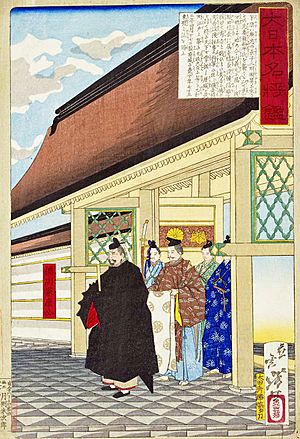
On March 24, 1603, Emperor Go-Yōzei gave Tokugawa Ieyasu the title of shōgun. Ieyasu was 60 years old. He had outlived all the other great leaders of his time, like Oda Nobunaga, Takeda Shingen, Toyotomi Hideyoshi, and Uesugi Kenshin.
As shōgun, Ieyasu spent his remaining years building and strengthening the Tokugawa shogunate. This new government started the Edo period, a long era of peace. The Tokugawa shogunate would rule Japan for the next 260 years.
Following a common Japanese tradition, Ieyasu stepped down from his official position as shōgun in 1605. His successor was his son and heir, Tokugawa Hidetada. Ieyasu might have done this to avoid ceremonial duties, to make it harder for enemies to attack the true power, and to ensure his son's smooth succession. Even though Hidetada was the official shōgun, Ieyasu still held the real power.
The Retired Shōgun (1605–1616)
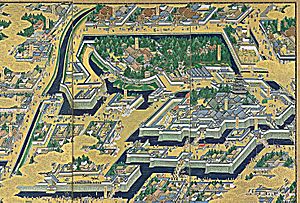
Building Edo Castle
From 1605 until his death, Ieyasu, now called the retired shōgun (ōgosho), remained the true ruler of Japan. He moved to Sunpu Castle but also oversaw the building of Edo Castle. This was a huge project that lasted for the rest of his life. It became the largest castle in Japan. The costs were paid by other daimyo, but Ieyasu gained all the benefits. Today, the Tokyo Imperial Palace stands where the castle once was.
In 1611, Ieyasu visited Kyoto with 50,000 men to see the new emperor, Emperor Go-Mizunoo, take the throne. In Kyoto, Ieyasu ordered changes to the Imperial Court and forced the remaining western daimyo to promise loyalty to him.
In 1613, he wrote rules called the Kuge shohatto, which put the court daimyo under strict control. In 1615, he prepared the Buke shohatto, a document that set out the future rules for the Tokugawa government.
Relations with Other Countries
As retired shōgun, Ieyasu also handled Japan's relationships with countries like the Netherlands, Spain, and England. Starting in 1609, Ieyasu chose to distance Japan from European influence. However, the government still allowed the Dutch East India Company to trade.
Ieyasu often consulted an English shipbuilder and pilot named William Adams. Adams, who was Protestant and spoke Japanese, helped the government with trade deals.
While Ieyasu was at first open to Christianity, his attitude changed after 1613. He became concerned about Spain's plans to expand its territory. In 1614, he signed an edict (official order) to expel Christians. This edict banned Christianity and led to all foreign missionaries being sent away. This greatly reduced foreign trade and marked the end of open Christian presence in Japan until the 1870s.
Conflict with Hideyori
The last remaining threat to Ieyasu's rule was Toyotomi Hideyori, the son of Toyotomi Hideyoshi. Hideyori was a young daimyo living in Osaka Castle. Many samurai who opposed Ieyasu gathered around Hideyori, believing he was the rightful ruler of Japan.
Ieyasu found fault with the opening ceremony of a temple built by Hideyori. He claimed it seemed to pray for Ieyasu's death. Ieyasu ordered Hideyori to leave Osaka Castle, but those inside refused and gathered more samurai. So, in 1614, Tokugawa laid siege to Osaka Castle against Hideyori.
The Siege of Osaka
The Tokugawa clan forces, led by Ieyasu and shōgun Tokugawa Hidetada, besieged Osaka Castle. This was known as "the Winter Siege of Osaka." The Tokugawa forces used cannons, which threatened Hideyori's mother. This led to negotiations and a truce.
However, once the treaty was agreed upon, the Tokugawa filled the castle's outer moats with sand. This allowed their troops to walk across, giving them a huge advantage through negotiation and cleverness. Ieyasu returned to Sunpu Castle. But when Toyotomi Hideyori refused another order to leave Osaka, Ieyasu and his army of 155,000 soldiers attacked Osaka Castle again in "the Summer Siege of Osaka."
Finally, in late 1615, Osaka Castle fell. Many defenders were killed, including Hideyori, his mother, and his young son. Hideyori's wife, Senhime (who was Ieyasu's granddaughter), pleaded for their lives, but Ieyasu refused. With the Toyotomi family line ended, there were no more threats to the Tokugawa clan's control of Japan.
Death
In 1616, Tokugawa Ieyasu died at age 73. After his death, he was given the special name Tōshō Daigongen, meaning "Great Gongen, Light of the East." A Gongen is believed to be a buddha who appears on Earth as a kami (spirit or deity) to help people. Ieyasu had wished to be honored as a god after his death to protect his family from evil.
His remains were first buried at Kunōzan. Later, many believe his remains were reburied at Nikkō Shrine, Nikkō Tōshō-gū, where they are thought to be today. Neither shrine has opened the graves, so the exact location of his remains is still a mystery.
Ieyasu's Character
Tokugawa Ieyasu had many qualities that helped him gain power. He was both careful and bold at the right times. He was clever and would change alliances if he thought it would benefit him. For example, he allied with the Hōjō clan, then joined Hideyoshi's army to destroy them, and then took over their lands himself. This was common in his time, an era of violence and betrayal.
He wasn't known for being personally popular, but he was feared and respected for his leadership and cunning. For instance, he wisely kept his soldiers out of Hideyoshi's campaign in Korea, saving their strength.
Ieyasu was very loyal to his personal friends and followers, and he rewarded them well. He was said to have a close friendship with his follower Hattori Hanzō. However, he also remembered those who had wronged him. He was also very strict when challenged. For example, he made very difficult decisions regarding his first wife and eldest son.
After the Siege of Osaka, he made sure the Toyotomi family would no longer be a threat. This meant that many who supported Hideyori, including his young son, were removed from power.
Unlike Toyotomi Hideyoshi, Ieyasu did not want to conquer lands outside of Japan. He only wanted to bring order, end the wars, and rule Japan.
While he was at first tolerant of Christianity, his views changed after 1613, and the number of Christians who faced punishment increased.
Ieyasu's favorite hobby was falconry (hunting with falcons). He believed it was excellent training for a warrior. He said it taught military spirit, the hard life of common people, and built physical strength. Ieyasu also swam often, even late in life.
Later in his life, he became interested in learning and Confucianism, supporting scholars like Hayashi Razan.
Here are two of his famous quotes: "Life is like unto a long journey with a heavy burden. Let thy step be slow and steady, that thou stumble not. Persuade thyself that imperfection and inconvenience are the lot of natural mortals, and there will be no room for discontent, neither for despair. When ambitious desires arise in thy heart, recall the days of extremity thou hast passed through. Forbearance is the root of all quietness and assurance forever. Look upon the wrath of thy enemy. If thou only knowest what it is to conquer, and knowest not what it is to be defeated; woe unto thee, it will fare ill with thee. Find fault with thyself rather than with others."
"The strong manly ones in life are those who understand the meaning of the word patience. Patience means restraining one's inclinations. There are seven emotions: joy, anger, anxiety, adoration, grief, fear, and hate, and if a man does not give way to these he can be called patient. I am not as strong as I might be, but I have long known and practiced patience. And if my descendants wish to be as I am, they must study patience."
It is said that he fought in 90 battles as a warrior or general. He was also interested in various sword fighting skills and supported the Yagyū Shinkage-ryū school, even having them as his personal sword instructors.
See also
 In Spanish: Tokugawa Ieyasu para niños
In Spanish: Tokugawa Ieyasu para niños
- Shitennō (Tokugawa clan)
- East Asian age reckoning
- List of Tōshō-gū
- Testament of Ieyasu


